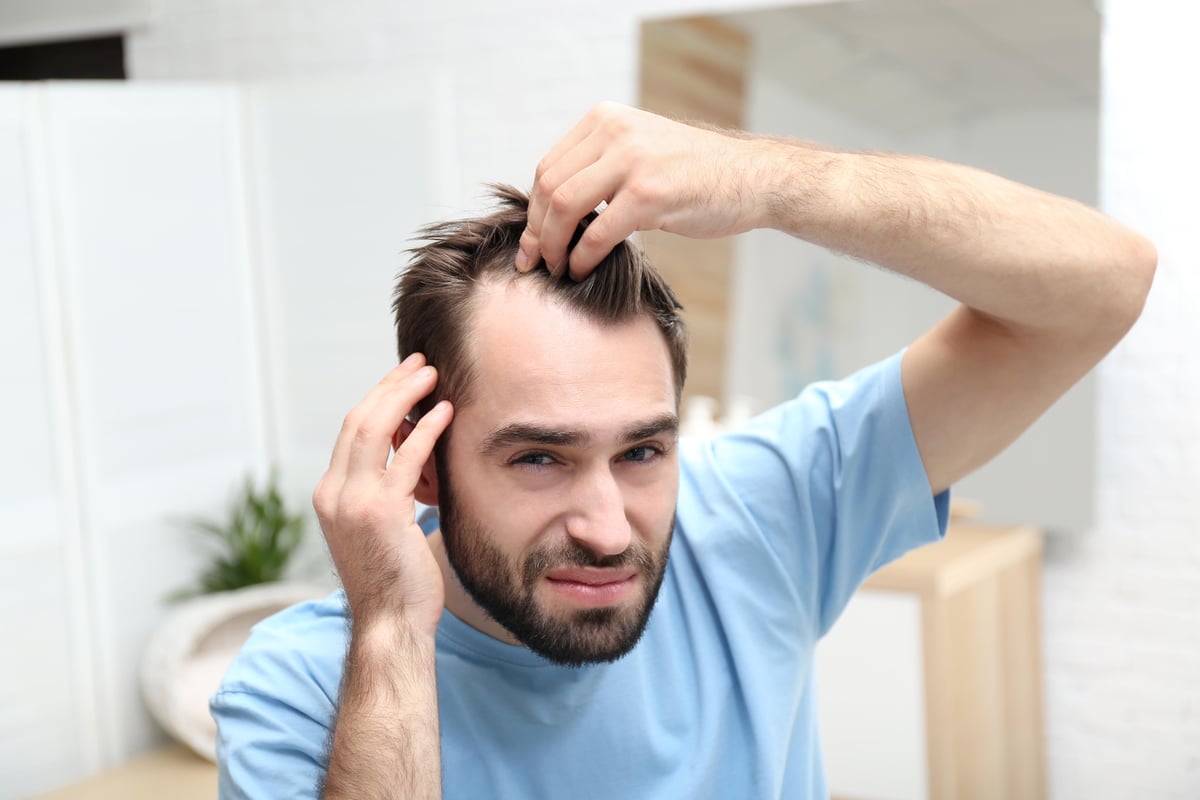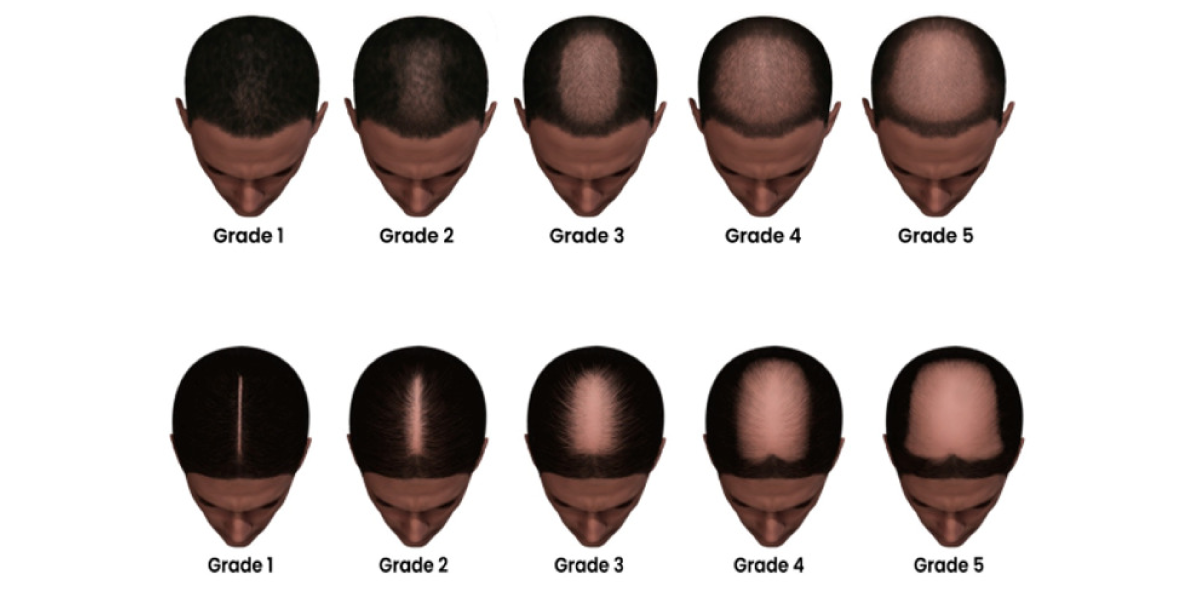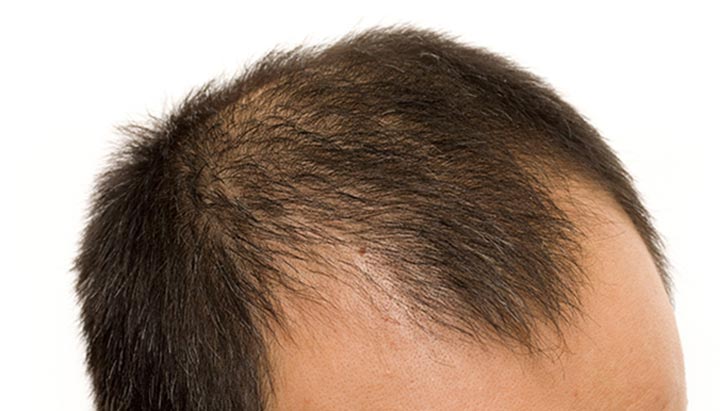Male pattern baldness, or androgenetic alopecia, is an ailment striking a vast majority of men, with statistics revealing a worrying trend of hair thinning in men by the age of 35. It’s not just a number game; the onset of hair loss treatment for men questions their aesthetics and challenges self-esteem, often tricking them into premature aging. Recognizing signs of balding early could lead to effective strategies for hair regrowth for men, leveraging treatments like minoxidil and finasteride.
The quest for combating male pattern baldness doesn’t end with pharmacological remedies; it extends to understanding the causes of hair loss, ranging from testosterone levels to genetic predisposition. While some opt for a hair transplant, embracing baldness becomes a choice for others. This article navigates through the maze of modern male pattern baldness treatments and arms the reader with knowledge to bolster both hair and confidence.
Understanding Male Pattern Baldness
Male pattern baldness, or androgenetic alopecia, is a condition that primarily stems from a combination of genetics, age, and hormonal factors, particularly dihydrotestosterone (DHT). This hormone is known to cause the miniaturization of hair follicles, which can lead to the common patterns of hair loss seen in affected men, such as a receding hairline, uniform thinning around the crown, and concentrated thinning atop the head. Here are some key points to understand:
Prevalence and Patterns:
- Affects approximately 30-50% of men by the age of 50.
- Commonly impacts the temples, vertex, and mid frontal scalp.
- Hair loss patterns include a receding hairline and bald spots.
Genetic and Hormonal Factors:
- Heredity accounts for roughly 80% of the predisposition to male pattern baldness.
- Ethnic heritage can influence the likelihood of experiencing this type of hair loss.
- The condition involves a hereditary response to male hormones, affecting hair on the scalp.
Pathophysiology:
- Key features include changes in hair cycle development, follicular miniaturization, and inflammation.
- Hair loss is characterized by sparse growth, receding hairlines, and bald patches.
- The discovery of the role of testosterone and DHT has led to treatments that target this hormonal pathway.
Understanding these aspects of male pattern baldness is crucial for identifying the most effective treatments and managing expectations regarding hair regrowth and maintenance.
Read : Natural Remedies for Hair Loss: Effective Solutions for Thinning Hair
Causes of Male Pattern Baldness

Male pattern baldness, influenced by both genetics and hormones, sees the androgen hormone dihydrotestosterone (DHT) at the forefront, shrinking hair follicles to produce increasingly finer strands until, ultimately, growth ceases. The process is gradual, often correlating with age, and by 50, half of the male population begins to notice its impact.
Genetic and Hormonal Factors:
- DHT’s role in follicle shrinkage leads to shorter, thinner hair.
- Genetic predisposition significantly affects the onset and progression.
Age and Associated Medical Conditions:
- A rise in baldness probability with advancing age.
- Links to medical conditions like prostate issues and heart disease, though unclear.
External Influences and Internal Changes:
- Certain hairstyles and treatments increase the risk of traction alopecia.
- Medications for unrelated health issues might contribute to hair loss.
- Hormonal imbalances, such as thyroid irregularities, and high stress levels can temporarily exacerbate hair shedding.
- Insulin resistance poses a potential risk, damaging follicles through elevated glucose and insulin levels.
Understanding these causes informs both prevention strategies and treatment choices, tailoring them to individual circumstances and enhancing their effectiveness.
Identifying Early Signs of Balding

Male pattern baldness, while not reversible, shows early warning signs that, when spotted, can lead to timely intervention. Here are the initial indicators:
- Receding Hairline: Often the first sign, hair begins to thin and recede at the temples, forming a characteristic “M” shape on the forehead.
- Crown Thinning: Hair at the crown of the head starts to thin, with the scalp becoming more visible.
- Widening Part: The part line in the hair can appear wider as hair loss progresses.
- Patchy Loss: Sudden hair loss in patches may signal an underlying health issue and warrants medical attention.
- Body Hair Thinning: Loss of hair on other body parts, like the legs and arms, can also be associated with male pattern baldness.
The timeline for these signs varies, with some men noticing changes as early as their teenage years, while others may not see signs until later. It’s important to monitor these changes, as they can gradually lead to partial or complete baldness. If one experiences sudden or patchy hair loss, it’s advisable to consult a healthcare provider to rule out other medical conditions.
Prevention and Early Intervention
Early prevention and quick intervention are crucial when it comes to male pattern baldness. As soon as hair thinning is noticed, particularly around the crown, it’s important to act promptly. Recent hair loss has the best chance of revival, so beginning treatment early is key. Here are some effective strategies:
Topical and Oral Treatments:
- Minoxidil: A topical solution that enhances circulation and nutrient delivery to hair follicles.
- Topical Finasteride: Reduces dihydrotestosterone (DHT) effects on hair follicles.
- Oral Minoxidil: Improves blood flow to support hair growth.
- Oral Finasteride: Inhibits the conversion of testosterone to DHT, slowing hair loss in most men and promoting regrowth in some.
Advanced Therapies:
- Plasma Injections (PRP): Injecting growth factors to stimulate hair follicles.
- Low-Level Laser Therapy (LLLT): Uses laser treatment to encourage follicle growth and strength.
Lifestyle Adjustments:
- Maintain a balanced diet with sufficient protein and iron.
- Manage stress through relaxation techniques or regular exercise.
- Treat underlying medical conditions that might contribute to hair loss.
- Avoid hairstyles that pull tightly on the hair.
For those embracing baldness, proper care of a shaved head is essential. This includes learning the correct shaving techniques, using the best razors, and applying bald head-specific sunscreen to protect against UV damage. Remember, hair retention is a continuous effort, with the bare minimum including daily use of 5% topical minoxidil. If hair loss is accompanied by other symptoms or sudden changes, seek medical advice to rule out underlying health conditions.
Modern Treatments for Male Pattern Baldness

In the evolving landscape of male pattern baldness treatments, innovative approaches are on the horizon. HairClone is a pioneer, developing an experimental cell therapy that involves banking a patient’s dermal papillae cells, cloning them, and injecting them back into the scalp. This method aims to rejuvenate follicles and restore hair to a youthful state, with plans to offer it experimentally within the next 12-18 months.
Northwestern University researchers have identified a potential game-changer: a tiny RNA particle, miR-205, which has demonstrated the ability to stimulate hair growth in aging follicles. Initial tests on mice show promising results, with plans to extend this research to topical applications for human trials.
Biotech firms are not far behind, with companies like Follicum seeking to address hair loss alongside other health issues. Cassiopea’s topical Breezula and JAK inhibitors like Eli Lilly’s Olumiant and Pfizer’s Litfulo are in the pipeline, though they come with their own set of potential side effects and risks. Meanwhile, Giuliani is delving into the molecular intricacies of hair growth and loss to inform future treatments.
While these cutting-edge treatments are being developed, established options remain in use. The FDA has approved medications like topical minoxidil and oral finasteride, which have been proven to halt or even partially reverse baldness. Hair transplant surgery, low-level laser therapy, and platelet-rich plasma (PRP) therapy offer additional avenues for those seeking restoration.
It’s crucial to consult with a dermatologist to explore these options, as the effectiveness and side effects can vary. Some treatments may not be suitable for everyone, and it’s important to set realistic expectations about the outcomes.
Embracing Baldness and Boosting Confidence
Hair loss, particularly male pattern baldness, can start early in life, and its impact on confidence is undeniable. However, it’s possible to shift the focus from loss to empowerment. Here are strategies for embracing baldness and boosting confidence:
- Role Models: Identify public figures or people in your life who are bald and carry themselves with confidence. Seeing others embrace their look can inspire you to do the same.
- Self-Compliment: Make it a habit to compliment yourself daily. Focusing on your strengths rather than perceived flaws builds mental resilience.
- Skin and Accessory Care: Invest in quality skincare and find accessories that complement your style. A well-maintained scalp and carefully chosen hats or glasses can enhance your overall appearance.
- Positive Focus: Redirect attention to your unique qualities and strengths. Whether it’s your sense of humor, intelligence, or kindness, let these aspects define you, not your hairline.
- Support Networks: Surround yourself with friends and family who offer encouragement. Online communities can also provide support and share experiences of dealing with hair loss.
By adopting these approaches, you can create a positive self-image that transcends hair loss. Remember, confidence comes from within, and embracing your look can lead to greater self-acceptance and psychological well-being.
Conclusion
Through examining the complex factors contributing to male pattern baldness, from genetic predispositions to hormonal triggers, we understand the importance of recognizing early signs and taking timely action through treatment or embracing change. With strategies for managing and treating hair loss readily available, from pharmacological options to lifestyle adjustments, individuals are better equipped to maintain their hair or gracefully accept baldness as a natural part of life.
As we conclude this exploration into the multifaceted world of male pattern baldness, remember that your confidence and self-esteem need not be defined by the quantity of hair. Whether choosing to combat hair loss with modern therapies or choosing to embrace a hair-free lifestyle, the path taken should bolster your sense of self and align with your personal values. For guidance on a tailored approach to hair loss treatments and to explore your options, consider consulting with a healthcare professional who can provide personalized advice and support.



